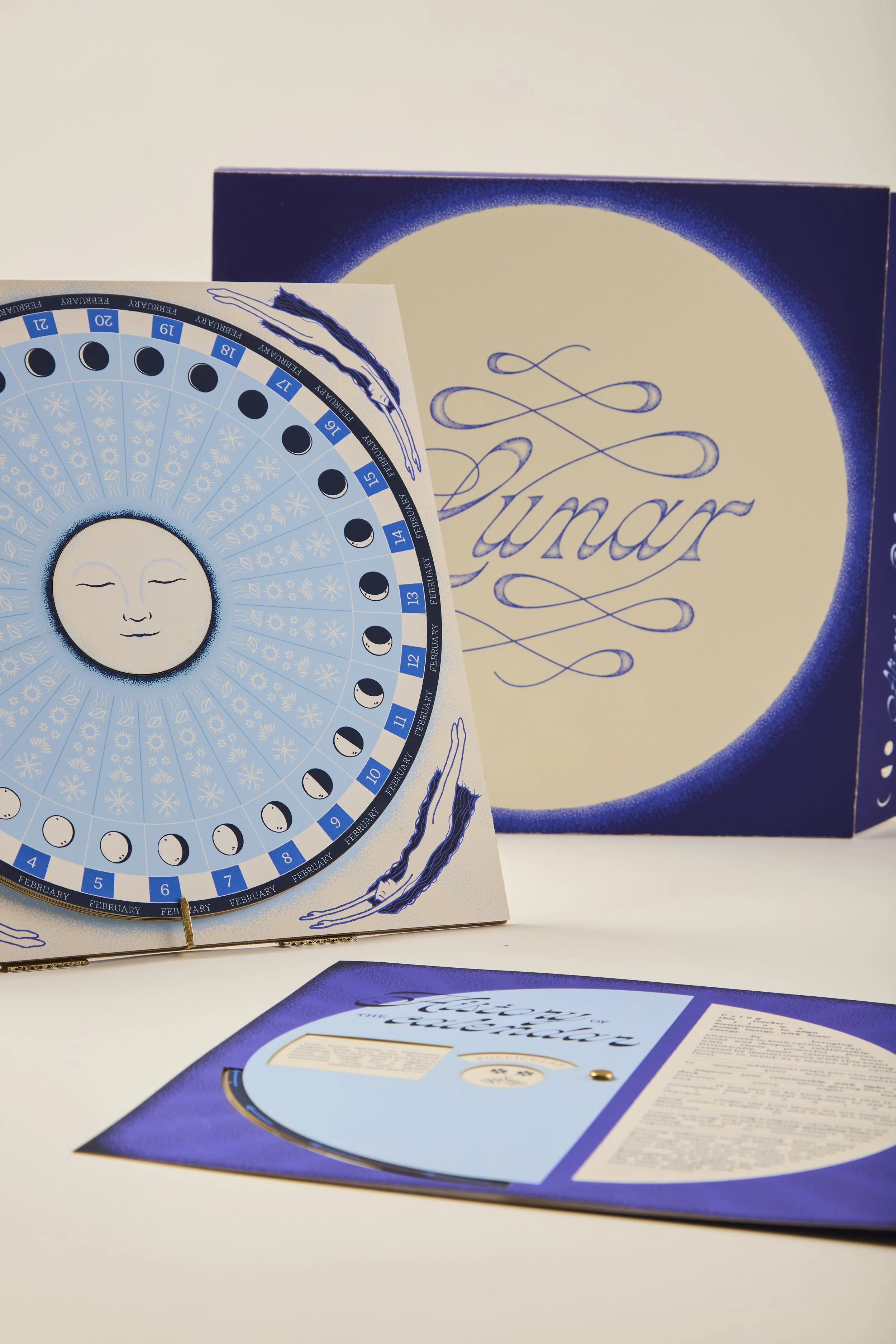Lunar
Rooted in ancestral wisdom, Lunar is a tactile experience for menstruators seeking to deepen the synchronicity between their bodily cycle and the phases of the moon.
While modern science questions the link between lunar and menstrual rhythms, history tells a different story: early societies used lunar calendars not only to track time, but also to follow menstruation in harmony with the moon. Lunar revisits and reimagines this practice as an empowering ritual, free from digital surveillance. By returning to manual cycle tracking, users are invited to reclaim bodily autonomy, resist data extraction, and reconnect with a rhythm as old as time.
PROJECT
ThesisDELIVERABLES
Calendar, Instructions & Exterior PackagingINSTRUCTOR
Mia CulbertsonYEAR
Spring of 2025AWARDS
Best Senior Thesis-
The initial concept of this project stemmed from my own challenges with regulating my menstrual cycle—an experience shared by many. Frustrated by the lack of comprehensive period education, I began independently seeking out resources to better understand my body. I had previously encountered the concept of synchronicity between menstrual and lunar cycles, which piqued my interest and seemed to offer rich potential for visual exploration. What began as a personal inquiry quickly unfolded into something much deeper.
However, my early research yielded underwhelming results. The scientific studies I encountered suggested a weak or inconsistent correlation between the menstrual and lunar cycles. Eventually, I came across the work of journalist and essayist Olivia Campbell. Her article, How Period Tracking Birthed the Calendar, provided exactly the perspective I was missing. Through her writing, I learned that menstruators meticulously observed lunar cycles to predict menstruation in ancient societies, leading to the creation of some of the earliest timekeeping systems. This historical insight became a pivotal turning point in the conceptual development of my project.
-
With this information, I moved on to figuring out how to configure the calendar itself. At first, I considered using a conventional rectangular calendar format, but upon deeper reflection, I felt compelled to be more ambitious. Given that this project centers around cycles, it felt necessary to pursue a design that echoed the form of a traditional circular lunar calendar.
Before I overwhelmed myself with the conceptual and structural complexity, I decided to seek out existing references that could guide my thinking. I visited the Special Collections Research Center at the Charles Library, hoping to find lunar calendars, movable books, or any visual framework that could inform my approach. I was incredibly fortunate to receive guidance from Kim Tully, the Librarian and Curator of Rare Books, whose expertise proved invaluable. With her help, I explored a range of materials—from 15th-century texts featuring astrolabes and volvelles, to contemporary artist books that were both beautiful and conceptually rich.
This research phase not only helped me clarify the structure of my calendar but also inspired many of my typographic and illustrative choices. The ornate swashes, serifs, and visual motifs I encountered informed the visual language of my project. Below are images of the incredible books that I got to (very carefully) hold in my own hands!
Creating exterior packaging was key to setting the tone for Lunar as an intimate, at-home experience.
The double-sided instruction manual includes a volvelle, allowing a rotating disc to reveal hidden information and create an interactive experience.
The calendar features 12 discs for each month of the year, which sit on the central fixed moon. The backboard is designed for versatility: it can stand upright on a desk, lie flat, or hang on a wall.
To use the calendar, the user rotates the current month's disc to align the date with the gold ticker at the bottom. They then mark the day of their menstrual cycle next to the date using a writing utensil, and place a gold sticker over their current inner season.
-
Lunar has truly taught me that design is an avenue for:
Problem-Solving
Education
Rebellion
Reclamation
Choosing this topic cracked open a hidden universe that’s led me into an entirely new world filled with power, history, and magic. I truly believe I could keep working on this project for eternity, as it expands every time I touch it, so I plan to continue this line of research. Creating something that I’m not only passionate about, but that also has the potential to support and empower others, has been an incredibly rewarding experience.
In addition, this project has given me the opportunity to use all the methods of making that I love—design, illustration, image-making… even nail art? The physicality of Lunar was especially satisfying: working with my hands during the design phase, printing, and constructing. I’m endlessly grateful to my classmates, professors, and friends who gently held me throughout this labor of love.
Photo documentation thanks to Kaitlyn Schnorbus



